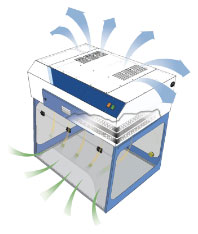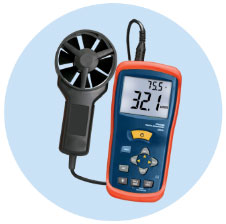What is a fume hood face?
The face of a fume hood is the plane between the bottom of the sash and the work surface. The hood pulls air from the laboratory into the fume hood through this opening. It also serves as the entry point to the work area.
What is face velocity?
Face velocity is the measured speed of air flowing into the fume hood’s face, measured in feet per minute (FPM). The recommended face velocity for fume hoods is 100 FPM. But, it’s best to check with local safety regulations because it can vary by state and use.
Face velocity is dependent on the amount of air going through the hood and the size of the opening. Fume hoods pull air through via a blower, creating a negative pressurized environment. The more air pulled through a hood’s opening, the faster the air will travel.
If face velocities are too high, air turbulence will occur between the fume hood’s face and the user. This is inefficient and will result in high energy costs as you exhaust large amounts of air from the room.
If the face velocity is too low, chemical fumes can escape the hood into the lab. This is, of course, dangerous for those around the hood.
Face Velocity Requirements
Different fume hoods can operate at different face velocities. Specific face velocities depend on several variables. The recommended face velocity is set by a safety officer or a local code. A traditional hood should be between 60 and 100 FPM. This may increase to 120 FPM if you’re working with toxic chemicals.
Variable air velocity (VAV) hoods take energy efficiency into account. When the sash is all the way open, the face velocity should be at 100 FPM. But, when you close the sash, the hood will conserve energy with less airflow. The face velocity of VAV hoods only gets as low as 60 FPM.
Testing Face Velocity
The face velocity test measures the speed of the airflow within a fume hood. Although face velocity is an adequate measure of performance, it isn’t the be-all and end-all. Many labs use face velocity as the only standard, but it only measures one aspect of hood performance.
Face velocity is the only test required by most orgs, so it’s often the only one performed. But, other tests can provide a better measurement of a hood’s ability to contain hazards. Many hoods meet face velocity requirements but are not able to pass air-flow and tracer gas tests. As with many situations, ensuring total safety is more complicated than a single test.
A digital anemometer is a testing tool consisting of a probe with a fan on the end. The probe measures airflow at different areas of the hood. For a fume hood to pass, its face velocity must be between 95-130 FPM.
To calculate average velocity, start by dividing the face into an imaginary grid. Each square of the grid should be approximately 1 square foot. Then, use the digital anemometer to take measurements at the center point of each square. Repeat until you have measured all squares. Then, analyze the measurements and look for outliers.
If any measurement is 20% over or under the standard then you may have a problem. Such readings state the possibility of turbulent or non-laminar airflow.
A laboratory can save a significant amount of energy if the hood can operate lower than 100 FPM. But, you must supply enough air to your lab to allow the hood to exhaust at its set volume. Otherwise the hood will create a vacuum within the lab. Not all hoods can operate at 60 FPM to relieve strain on an HVAC system.
ASHRAE 110 Test
The ASHRAE 110 Method is the industry testing standard. This test ensures that the face velocity meets the requirements.
This process goes beyond measuring the performance of a hood by its face velocity rating. It also tests the hood’s ability to contain and exhaust fumes.
The three-part test includes:
- Face velocity measurements
- Smoke visualization
- Tracer gas containment
Fume hoods are first tested after they’re manufactured (AM) to ensure that they work. This occurs in a controlled testing lab.
After installing a new fume hood, you should test it in two operating conditions; as installed (AI) and as used (AU).
The AI test occurs when the hood is empty and in its final location. This test ensures that the ventilation system works, but isn’t tested with any fumes.
The AU test occurs after the hood has been in use by the customer. The equipment and tools remain in the hood and activities in the laboratory continue.
While the AM test takes place in a controlled lab, the AI and AU tests happen in real environments.
Diffuser Check
Diffusers supply air to laboratories. These devices make up for the air that is being exhausted out of the building. If air currents from the diffusers reach the face of the hood, they can cause fumes to blow into the lab. Make sure to balance and replace diffusers if velocities become too high.
Foot Traffic Analysis
Ensure that foot traffic isn’t directed in front of the hood. This is important if the face velocity is on the lower end of the acceptable FPM range. The average human produces a vortex of air behind them as they walk. This vortex can pull fumes out from the hood into the laboratory.
Assessing Face Velocity Results
In a standard hood, it is unlikely that velocities below 0.4 m/s can contain contaminants. In special situations, some fume hoods can operate at low face velocities.
When fume hoods have face velocities outside the recommended value, you must fix them.
The following conditions can cause insufficient airflow:
- An inrush of air into the room through a door or an open window
- Ventilation system imbalance
- Bulky equipment
The speed at which air enters a fume hood determines its effectiveness. A speed that is too high or low can compromise the performance of the hood.
How often do hoods need face velocity testing?
Conduct face velocity testing every three months, according to OSHA standards.




